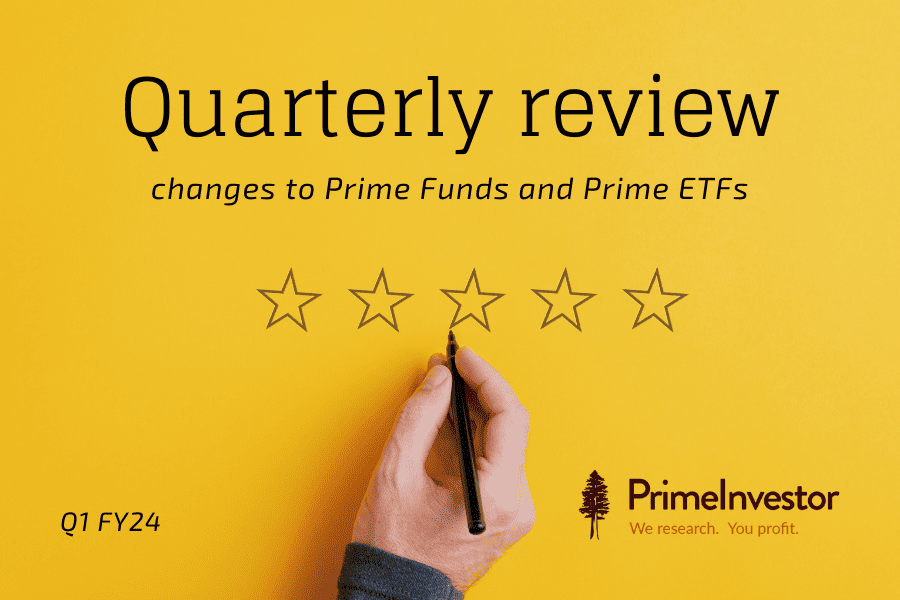Prime Funds is our list of recommendations in equity, debt, and hybrid mutual funds that are worth investing in. Prime Funds narrows down your choices from the thousands of funds that there are into a concise list of funds that span different styles. Prime Funds are selected based on performance, portfolios, and investment strategies.
In this review, we have made two key removals from the funds list. Changes also take into account the changing tax landscape. Use the Table of Contents below to directly go to the section that interests you.
About Prime Funds
Prime Funds is our list of best mutual funds across the equity, debt, and hybrid categories. We use Prime Ratings, our fund ratings, as a first filter. We then apply qualitative analysis to arrive at our fund recommendations. Prime Funds is an enduring list of funds that you can use at any time. You will always find a fund to meet any goal you’re looking to meet.
Different categories: Prime Funds are separated into buckets, based on risk level in equity & hybrid funds and timeframe in debt funds. Each of these draws from different SEBI-defined categories. We have classified them in a more user-friendly way than using the several dozens of SEBI categories. We do not go only by Prime Ratings but look at other factors as well to narrow the list and make the choices easy for you.
Different styles: In Prime Funds, we’ve aimed at providing funds that follow different strategies for you to mix styles and diversify your portfolio with ease. The ‘Why this fund’ for each Prime Fund will brief its strategy, why we picked it, and how to use it in your portfolio.
Direct plans: We have specifically given the direct plans in Prime Funds. If you wish to know whether it is ok for you to use the regular plan of the fund, check our MF Review Tool (not our Ratings). If the review specifies ‘buy through direct,’ it means that the expense ratio differential is high under the regular plan for that fund. You will be better off using the direct plan in such cases. You can also check the expense ratio differential using our expense ratio tool.
Quarterly review: Our aim in reviewing the Prime Funds list every quarter is to ensure that we don’t miss any good opportunities that are coming up and we are not holding on to funds that are slipping. When we remove funds from the Prime Funds list, we tell you exactly what to do if you have invested in these funds. Funds we remove do not immediately call for a sell – it is just that they have slipped in performance marginally or there are better alternatives now. Unless our review tool says such funds are a ‘sell’, you can hold them (refer to our article on when to sell funds)
Using Prime Funds: You don’t need to hold every Prime Fund nor add any new fund we introduce to the list. Unless it fits your overall portfolio/strategy, or there is something lacking, there is little need for you to go on adding funds. Our idea of covering them in detail through some of our weekly calls is to let you know the strategy, style, and suitability in different portfolios. It is not a specific call to buy right away, unless we mention that it is a ‘tactical’ or ‘timing’ call.

Equity funds
Stock markets have staged a strong comeback after peaking in December 2022, and being range-bound for the early part of the year. The rally has also expanded outside the large-cap basket to pull in the mid-cap and small-cap segments. Multiple factors have come into play all at once – foreign investor buying activity is up sharply, global markets are shrugging off recession concerns, the Reserve Bank has paused interest rate hikes, and corporate earnings are picking up in some key sectors.
The broad-basing of market recovery has slightly reduced the performance divergence between funds over the past few months. However, there is still a wide margin of performance differential between funds within a category given that some stocks and sectors have seen a very rapid up-trend. This is especially true in the mid-cap and small-cap categories.
Over 2022, we undertook a good number of changes to our fund recommendations to weed out the underperformers and introduce better-returning options. These changes have held up very well, and performance of Prime Funds has been above benchmark or category.
In this review, we are further cutting back on those funds that failed to sustain performance improvement. We are also making a key change in the ELSS (tax-saving mutual funds) recommendations.
Equity – Moderate (Active)
We have made no changes in this review. In our earlier review, we had discussed the performance improvement of two earlier underperformers – Mirae Asset Large Cap and Canara Robeco Flexicap. The latter has cemented its recovery and remains firmly above the Nifty 100 TRI across timeframes. Mirae Asset Largecap, on the other hand, has again shown signs of slowing down in recent returns where the margin of outperformance has narrowed in 1-year returns. Long-term 3-year performance, however, continues to hold up.
The fund’s strategy is to go overweight or underweight on sectors within the benchmark index; while it is swift in such changes its current heavier weight towards HDFC & HDFC Bank could have hurt returns in the run-up to the merger. The fund also holds marginally higher allocation to large-cap IT stocks.
For now, we are not removing the fund from our list as long-term performance is not yet affected and because the fund’s sector weights could still help returns improve. We will continue to keep a watch on performance and will alert you if any action is needed.
Equity – Aggressive (Active)
In this Prime Funds set, we are removing SBI Focused Equity. We had noted the underperformance of this fund in our December 2022 review. Focused funds are especially susceptible to a few stock calls not delivering up to mark. For SBI Focused, its few overseas exposure had weighed on returns earlier. Now, a few other portfolio picks – such as insurance, private banks, consumption – turned laggards.
This has led to uneven returns; the fund’s underperformance (rolling 1-year returns) compared to the Nifty 500 TRI ballooned to 8-9 percentage points, then shrunk significantly but has now begun to widen again to 2-3 percentage points now. The fund is also behind on longer-term returns. With this fluctuating performance, we would like to pull it off our recommendation list until we see some stability in returns. SBI Focused otherwise holds a portfolio of sound stocks and tends to take long-term calls.
Continue to hold investments made so far in the fund and do not exit. If you have SIPs, you can stop them if there are more than a few instalments left.
The second fund we are removing is Mirae Asset Emerging Bluechip. We had noted the flagging performance of this once-invincible fund in our September 2022 review. We had attributed it to the general rout in mid-caps then, and some profit-booking by the fund. However, performance has not picked up much since then. 1-year returns have been trailing the Nifty LargeMidcap 250 since June 2022 and the gap between returns has widened to 5-6 percentage points now. The drop in returns has spilled over into longer-term 3-year returns as well.
Multiple stocks across both the large-cap and mid-cap segments have failed to take off; for example, some banking & finance stocks have delivered poorly. So have select energy and consumer plays. All this has resulted in the fund lagging peers as well.
The fund has been a solid long-term performer. However, given that markets currently are favouring the mid-cap and small-cap segment, the worsening performance makes us cautious. Further, the fund was already restricting inflows. The category overall has also not shown a clear return advantage. For all these reasons, we would prefer to be conservative and avoid making any further increase in investments.
Continue to hold all investments made so far in the fund; should it return to its earlier track record, returns can pick up. If you have SIPs, you can stop them if there are more than a few instalments left.
We are not adding any new fund in this set – there is enough variety in terms of aggression and fund style to build a portfolio. We’d however like to draw your attention to the performance of two funds:
- Quant Active, a multicap fund that is under the ‘Tactical’ set, has been slipping in performance. This has come as a nasty surprise to many of you used to seeing outstanding returns from the fund. However, we are not concerned about performance as yet. The performance can be mostly attributed to slightly contrarian and early-mover sector calls that the fund has taken in healthcare and consumption, as well as being underweight on current sector leaders such as auto and finance. This is not unusual given the fund’s strategy of shifting bets as it reads market movements. We will watch the performance and take a call if necessary.
- PGIM India Flexicap, which is more aggressive in mid-and-small-cap allocations than peers, has not been doing as well as other funds in the Prime Funds set. This can be attributed to sector calls, and within it, some picks not performing up to mark. The fund has significantly narrowed the gap by which it trails the Nifty 500 TRI and is now marginally outperforming. The fund also has a new manager in Vinay Paharia, who was responsible for the turnaround in fund performance in Union AMC and had delivered index-beating returns in funds he managed in Invesco AMC. We will therefore give time for the fund to pick up performance before making any call.
A quick note – Nippon India Smallcap, Motilal Oswal Nasdaq 100 Fund of Fund and Motilal Oswal S&P 500 Fund of Fund currently have restrictions on lump-sum investments. They may open up from time to time. Please check with the platform you are using for investing to know the latest rule.
Equity – ELSS
We are removing this Prime Funds set entirely. The primary reason is that, with the new tax regime the relevance of ELSS is significantly diminished. As we explained when discussing the old vs new tax regime, the old tax regime with its tax deductions is useful primarily if you have home loans – which leaves little room for ELSS funds.
This apart, fund performance in the ELSS category is extremely uneven with funds soaring suddenly and falling sharply in the performance chart. With limited applicability and fluctuating performance, there is no necessity to separately recommend ELSS funds in the Prime Funds list.
If you need ELSS recommendations, you have two options. One, check Prime Ratings or MF Review Tool and invest in funds with a Buy call; we review the calls in this tool every quarter as part of our regular review cycle. Two, use the Tax-saving Prime Portfolio. This is also reviewed on a quarterly basis; ‘Follow’ the portfolio to receive alerts when we make changes.
Equity – strategy/thematic funds
With a more broad-based rally setting in this year, we have seen our sector fund calls on transportation, consumption and healthcare do well. Our active banking sector fund outperformed the passive one as a more broad-based rally is happening in the financial space. We see more financial service companies – NBFCs, microfinance companies, insurance and other financial plays – participating in the rally.
To capture this better, we are adding Nippon India Banking & Financial Services Fund (Nippon Banking) and removing the Motilal Oswal Bank Nifty Index fund. If you hold the latter fund, you can continue with it as its prospects remain good. Any fresh exposure can be done with the Nippon or ICICI Banking fund, if your exposure to sector funds, per se, is still low. If you hold the ICICI Pru banking fund, do not take any fresh exposure to the Nippon India fund we have just added.
Nippon Banking has marginally higher exposure to non-banks than ICICI Pru and may help play this broad based rally better, but it is also more volatile. The ICICI fund also holds slightly higher cash thus reducing volatility. Nippon Banking is suitable only for risk takers. Make sure you do not go overboard on sector funds. Exposure can be in limited lumpsum or in phases.
With the manufacturing space seeing a strong rally, we think the entry point is restricted to select stocks. Hence, we are removing Kotak Manufacturing India fund. If you are invested, continue to hold it as part of your long-term portfolio and avoid fresh exposure. For those looking for newer pastures, do choose our Consumption fund from Prime Funds.
Hybrid funds
Hybrid Equity – Moderate risk
We have no changes in this segment. However, we wish to take note of the fact that there is visible divergence in the performance of funds in this space. This difference stems from funds with higher gilt in their debt allocation gaining more than those that have lesser exposure to gilt.
For example, high performers like Quant Absolute have seen a bit of a slow down than some peers in recent times (the fund still remains among the top performers in terms of consistency). It holds more cash and cash equivalent than gilt. A few other funds that have high exposure to gilt have seen superior performance. But do note that in a hybrid aggressive category, we expect debt to provide effective hedging rather than generate high returns. To this extent, we prefer those with less aggressive debt strategies.
Hybrid Equity – low risk
With the change in debt taxation, many of you have been asking us for more tax efficient options with lower risk than equity. While we already have a few funds, we are adding one more, UTI Equity Savings, to this list.
As with all equity savings schemes, this fund is less aggressive than balanced advantage/dynamic asset allocation schemes and hedges a larger portion of its equity. It has consistently beaten its category on a rolling returns basis, albeit with marginally higher volatility than the other fund in our list – Kotak Equity Savings. However, this volatility stems from its more active approach in debt where it takes gilt exposure. This might work in its favour in the coming quarters.
For those wanting to increase exposure to this category, you can use the UTI fund in addition to Kotak Equity Savings. The Kotak fund may be a better option for those looking for lower volatility or simply wanting to book equity profits and park them in this category. Do remember, this fund and the category in general, is not a substitute for debt. You can face losses in the short term when equity falls.
Debt funds
In debt funds, the last one year has seen a significant ramping up in yields, especially in the shorter duration space. Shorter duration funds tend to see quicker outcomes in returns when yields move up. As their papers mature faster, they add more higher yield papers and up their average yields quickly. Higher interest income too therefore begins to show up in the NAV quickly.
The 1-year returns of liquid funds match or even surpass many short and medium duration funds. And after a hiatus, the 1-year returns of gilt and constant maturity funds are also upward of 7%.
At this juncture, we think it is prudent to mix short and long duration to tap the different return potential (accrual in short term and NAV appreciation from rate fall in the long term) for long-term portfolios. Shorter term portfolios are best built with very-short to short duration funds.
Debt - Short term - 1.5 to 3 years
With short-term yields rising significantly, short-term and corporate bond debt funds now sport yields comfortably upward of 7.5%. Hence, you now have more options compared with target maturity funds. We are therefore removing Bharat Bond FoF April 2025 from our list. You can continue to hold the fund till maturity as you may enjoy indexation if you had entered before April 1, 2023 and held for 3 years. But with indexation benefits going away, superior yields or ability to rally in a rate fall scenario will determine the choice of funds hereon. We have enough options in our Prime Fund list to play this space now.
The full list of Prime Funds is here: Prime Funds
Prime ETFs
Prime ETFs is our list of recommended ETFs in equity, debt, and gold. We look at multiple factors to draw up this list, ranging from short-term and long-term tracking error, expense ratio, trading volumes and usefulness of the index in a portfolio. In this review, we have made one change.
Equity – High risk
We have replaced Nippon India ETF Nifty Midcap 150 ETF with Mirae Asset Nifty Midcap 150 ETF. We have made this change simply because the Mirae fund has a marginally lower tracking error despite being a relatively new fund. We also want some diversity in fund houses. The Mirae ETF’s traded value is still not as high as Nippon but is large enough to accommodate retail orders. You can continue to hold Nippon as the difference is not significant enough to switch. Please ensure exposure to midcaps is done in phases at this point. Do not go overboard considering that this market cap segment can also sink faster after a rally.
Equity – Strategy & thematic
There are no changes in this space. But we want you to be cognizant of the restrictions in inflows in international ETFs. Such inflow restriction can cause a deviation of the market price of the ETF from its NAV due to erratic demand-supply, although AMCs endeavour to even this out with market making.
We are seeing such deviation in both the international ETFs in our list - Mirae Asset S&P 500 TOP 50 ETF and Motilal Oswal Nasdaq 100 ETF. Avoid large sums in one go, given this deviation. Buy gradually or through SIPs.
You can refer to the list of all our recommended ETFs here: Prime ETFs






7 thoughts on “Quarterly review – changes to Prime Funds and Prime ETFs”
Team – How can one identify how much equity portion in a mutual fund has been hedged via derivates? Was looking at a couple of equity savings funds’ portfolio (including one of your recommendations), but couldn’t find the breakup of hedged and unhedged equity anywhere (They seem to club both under one equity header). Let me know if there is any helpful source for this. Thanks in advance.
This data will be available in our MF Screener. – thanks, Bhavana
Wonderful, thanks Bhavna.
Dear team,
Am holding SBI focused equity fund since 2019. Stopped investing from 2023 (as per our last call) Shall I continue to hold or redeem and switch to another fund? Please advise.
Thanks, Vijay
Continue to hold all investments so far and do not exit. As explained in the review above, stop SIPs if you have more than a few left. There’s no need to exit at this point. – thanks, Bhavana
Hi Team PI,
You have included UTI Equity Savings Fund under Prime Funds. With AUM of just INR 275 Crores after 5 years of existence, should it not be avoided as AUM is too low to handle spate of withdrawals?
Regards
Jatin
No, AUM is not a concern. Stocks have liquidity, so meeting redemptions will not be like it could be for a debt fund. Debt funds also see sudden heavy withdrawals due to credit events that spook investors; this is also a smaller risk in equity savings funds. – thanks, Bhavana
Comments are closed.